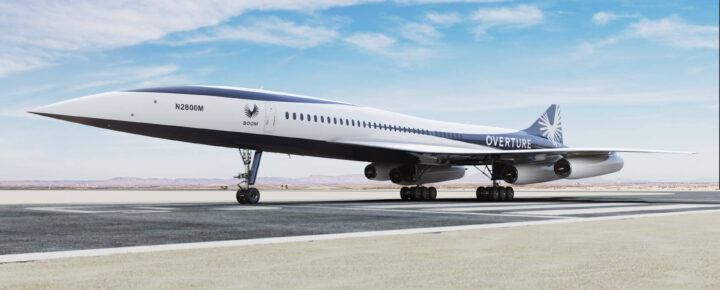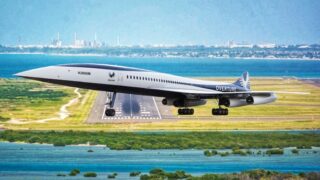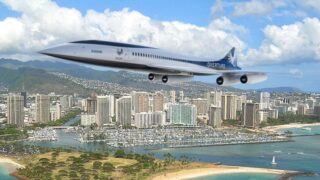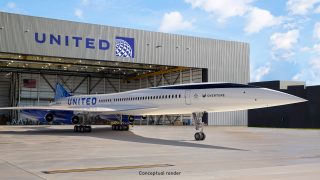Boom Supersonic is advancing on its ambitious goal of returning supersonic air travel to the skies—a development that could in the not distant future revolutionize flights to Hawaii. With Boom’s supersonic demonstrator, XB-1, just completing its third flight, the islands stand to benefit from potentially halved flight times, opening new possibilities for travel.
Boom’s planned supersonic passenger airliner, Overture, aims to fly travelers between the U.S. mainland and Hawaii in less than half the current time. Although XB-1 is a test aircraft, not a passenger vehicle, it plays a huge role in laying the groundwork for this future.
Boom has garnered interest from major airlines, with American Airlines, Japan Airlines, and United Airlines all signing agreements for Overture orders and pre-orders. Together, these carriers have agreements for a combined 130 aircraft, a clear signal of strong industry support for the future of supersonic flights.


Recent and upcoming flight milestones include supersonic speed.
Boom’s supersonic demonstrator, XB-1, recently took to the skies again at the Mojave Air & Space Port in California. The company continues to expand the scope of test flights, gathering critical performance data for the future development of Overture, its planned passenger airliner.
Boom’s supersonic test program is progressing rapidly, with the company aiming to achieve supersonic flight before the end of 2024. This milestone would bring the prospect of flying to Hawaii at supersonic speeds even closer to reality.
The FAA has granted Boom a Special Flight Authorization (SFA) to exceed Mach 1, allowing the company to test supersonic operations in airspace traditionally used for military and research purposes. Boom plans to conduct 10 more test flights with XB-1 before achieving supersonic speeds—a highly ambitious goal, as these milestones are expected to take place within the next 90 days.
The return of supersonic travel? What it could mean.
While XB-1 serves as a test-bed for Boom, the aviation industry and Hawaii travelers are eagerly awaiting the launch of Overture, the company’s actual supersonic passenger plane. Overture hopes to carry passengers at speeds up to Mach 1.7—more than twice the speed of current commercial jets—drastically reducing flight times to Hawaii. For example, Overture could travel from Los Angeles to Honolulu in under three hours.
Faster travel times between Hawaii and major West Coast cities could be a game-changer for the islands’ tourism industry. Hawaii, known for its luxury and allure, has long dealt with the challenge of its remote location, where long flight durations are the norm. By cutting travel time, Boom could attract more visitors and unlock new opportunities across the islands.
Boom Overture is, according to the company, designed to be net-zero in carbon emissions and run on 100% sustainable aviation fuel (SAF), aligning with Hawaii’s eco-conscious future and the state’s focus on environmental preservation.
Not without big challenges and considerations.
While the prospect of supersonic travel to Hawaii is exciting to some, there are multiple challenges and considerations to keep in mind. One of the main concerns surrounding supersonic flight is its environmental impact. While Boom has emphasized an ability to use 100% sustainable aviation fuel (SAF) and achieve net-zero carbon emissions, supersonic aircraft typically consume far more fuel per passenger than subsonic jets. This increased fuel consumption raises important questions, especially when compared to the highly efficient subsonic flights that already serve Hawaii.
Additionally, supersonic travel is limited by the “sonic boom,” the loud noise created when an aircraft breaks the sound barrier. Current regulations prohibit supersonic flight over land, meaning Overture would only be able to fly at supersonic speeds over the ocean. While this makes Hawaii a viable destination, it limits the reach of supersonic routes to West Coast cities like Los Angeles, San Francisco, and Seattle.
Cost is another significant consideration. Supersonic travel has historically been very expensive, and while Boom aims to make Overture more affordable than Concorde, ticket prices are still expected to be higher than typical first-class fares. This could make supersonic flights less accessible for the average traveler.
Finally, as with any new technology, there are still unknowns to address. One of the biggest challenges revolves around Boom’s engine strategy. After Rolls-Royce exited the project in 2022, Boom shifted to developing the Symphony engine in-house. While this move allows Boom to maintain control over the design, it has added significant complexity and cost to the project. Although Boom has started combustor tests and remains optimistic, developing a reliable, efficient engine that meets performance, reliability, and sustainability standards remains both a frequently cited concern and a critical hurdle in making Overture a reality.
As XB-1 progresses through test flights, Boom will tune its performance with the goal of reaching supersonic speeds in the next 90 days. These flights lay the groundwork for Overture, which Boom hopes will begin carrying passengers at the end of this decade. For Hawaii, this means the dream of faster, more efficient travel appears to be progressing steadily.
We’ll all be watching to see if Boom Supersonic marks a milestone for aviation and a glimpse into future Hawaii travel.
Do you believe that the future of supersonic travel to Hawaii is a bright one?
Lead image: Boom Overture.
Get Breaking Hawaii Travel News






This was already done years ago with Concorde which actually holds more passengers! Why wouldn’t they just modernize Concorde as it’s already a proven airframe? One accident in Concordes history through no fault of its own.
After making and canceling plans and tickets and reservations to Hawaii during the “covid era”, I am hesitant to go there. Mexico was my refuge during this period. I can drive or fly there and they are glad to have us.
Hoping Xb1 will bring back memories of the great Concorde. God speed
DOT just approved HA/AS merger
All the speculation on what supersonic flights may cost is academic. The Overture airplane will never exist. It is the aeronautical equivalent of vaporware. There is no engine, and no credible plan for an engine, and there never will be. And Boom’s funding to complete the project is inadequate by a factor of 20 or more. Sorry folks, get used to the rides in the back of a 737 or A320 from now to eternity.
Jeff and Rob: Is Jon correct? Is all this just a pipe dream?
Hi Bruce.
We stated the obvious issues, and there are different points of view for a variety of reasons, as you’ve seen that on our other articles. We’re watching this closely as is the entire airline industry. If the whole project was vaporware, would American, United and Japan Airlines even want to be associated with it?
Aloha.
I wouldn’t call it vaporware. They have investors and are doing work. In aviation it’s not unusual to see this. That’s how Bill Lear got started and the Learjet was born. There are still people around like Bill and investors willing to roll the dice. Bill also invented the aircraft that eventually became the CRJ after numerous zigs and zags. When that segment was born there were 6-7 companies working on RJ’s. It quickly consolidated and 2 or 3 survived. My point is that you never know so keep reporting. Large airlines always participate but with many exit doors. Did you know that the very same thing is happening in the personal mobility sphere? There are a hand full of start-ups building tiny all electric aircraft to shuttle high value pax between major airports and “downtown” NYC, London, Paris, Tokyo etc. Almost every one has “orders” from several major airlines including internationals. Several prototypes have flown and each have seen new investments appear.
Just what we need,
A faster way for rich people to get to Hawaii ☹️🤔
Tom & Beth
We will continue to “get what we pay for”. Boom doesn’t have any real technological breakthroughs except the reduction of the sonic boom it generates. So tickets will be too expensive for 90% of today’s HI visitors (if it ever actually becomes operational). SAF is no more climate friendly than oil-based jet fuel. It costs 4x as much and its’ proponents conveniently only count part of the pollution it causes. Just like most other “green” tech.
In the airline industry, orders for aircraft are much different than actual sales.
Keep us informed but it’s not going to ever be rea$onable enough to actually impact the HI market.
So, does that mean we can pay $4000 extra to save 3-4 hours in flight time?
This article would be more interesting if it included a picture of the actual aircraft. Lacking such causes me to doubt its claims.
Now do a story on how much a Concord ticket was.
Time is money. I bet the time saving will cost a bunch. I noticed that this aircraft is a single engine. Sorry one engine one chance. At least when dual engine aircraft loose one engine the plane can fly with the other in which I’ve heard. Sounds like luxury plane equals luxury ticket prices.
I see 4 engines below the wings.
you are looking at “renderings” the ” new speak” word for frawings, sketches, etc. The boom demonstrator (actual aircraft) is a songle seat multi engine nothing burger… consisting of Nothing that the renderings show.
Aloha Jeff and Rob,
We just reviewed the Boom website. Impressive! Thanks to your post, we just added another experience to our bucket list. YOLO. 🙂 Keep ’em coming.
Mahalo!
So, how much will an average ticket from the mainland cost?
If it exceeds $1200 round trip, Boom will only bring a limited number of very wealthy visitors and regular folks will suffer while high end resorts laugh all the way to the bank. Stop making Hawaii the land of the rich and the home of the poor…
Much like landing people on the moon and nuclear power, we never should have abandoned supersonic flight to pacify the few.